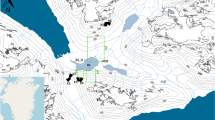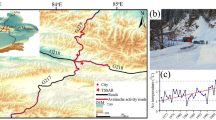Abstract
The occurrence of wet-snow avalanches is, in general, poorly understood. For 20 years (winters of 1975–1976 to 1994–1995), the avalanche activity has been observed in the Dischma valley near Davos (Eastern Swiss Alps). The study area comprises a large starting zone of north-easterly aspect (2,300 m a.s.l.) with several avalanche paths. We have analyzed the occurrence data in combination with meteorological and snowpack data collected at an elevation of 2,090 m a.s.l. During the 20-year observation period, almost 800 wet-snow avalanches were observed, about 4.5 times more loose snow avalanches than slab avalanches. Considering both types of avalanches jointly, snow depth, precipitation and air temperature showed the highest correlation with avalanche activity. Most loose snow avalanches occurred when air temperature was high and/or after a precipitation period. Slab avalanches occurrence was primarily related to warm air temperatures and snowpack properties such as the isothermal state and the existence of capillary barriers. Radiation did not show up as a significant variable. The results suggest that in a transitional snow climate wet-snow avalanches are, as dry snow avalanches, often related to precipitation events, and that wet slab instability strongly depends on snowpack properties in relation to warming of the snowpack and melt water production.





Similar content being viewed by others
References
Armstrong RL (1976) Wet snow avalanches. In: Armstrong R, Ives JD (eds) Avalanche release and snow characteristics, San Juan Mountains, Colorado. Sun Juan Avalanche Project, Final report 1971–1975, Occasional paper no. 19. Institute of Arctic and Alpine Research, University of Colorado, Boulder, CO, USA, pp 67–82
Breiman L, Friedman JH, Olshen RA, Stone CJ (1998) Classification and regression trees. CRC Press, Boca Raton, USA, p 368
Brun E, Rey L (1987) Field study on snow mechanical properties with special regard to liquid water content. In: Salm B, Gubler H (eds) Symposium at Davos 1986—avalanche formation, movement and effects, IAHS Publ., 162. International Association of Hydrological Sciences, Wallingford, Oxfordshire, UK, pp 183–193
Colbeck SC (1975) A theory for water flow through a layered snowpack. Water Resour Res 11(2):261–266. doi:10.1029/WR011i002p00261
Colbeck SC, Akitaya E, Armstrong R, Gubler H, Lafeuille J, Lied K, McClung D, Morris E (1990) The international classification of seasonal snow on the ground. International Commission on Snow and Ice (ICSI), International Association of Scientific Hydrology, Wallingford, Oxon, UK, p 23
Clarke JA, McClung DM (1999) Full-depth avalanche occurrences caused by snow gliding, Coquihalla, BC, Canada. J Glaciol 45(151):539–546
Davis RE, Elder K, Howlett D, Bouzaglou E (1999) Relating storm and weather factors to dry slab avalanche activity at Alta, Utah, and Mammoth Mountain, California, using classification and regression trees. Cold Reg Sci Technol 30(1–3):79–89. doi:10.1016/S0165-232X(99)00032-4
de Quervain MR, de Crecy L, LaChapelle ER, Losev K, Shoda M (1973) Avalanche classification. Hydrol Sci Bull 18(4):391–402
Hendrikx J, Owens I, Carran W, Carran A (2005) Avalanche activity in an extreme maritime climate: the application of classification trees for forecasting. Cold Reg Sci Technol 43(1–2):104–116. doi:10.1016/j.coldregions.2005.05.006
Jordan R (1996) Effects of capillary discontinuities on water flow and water retention in layered snow covers. In: Agrawal KC (ed) Proceedings of the international symposium on snow and related manifestations, 26–28 September 1994, Manali, India. Snow and Avalanche Study Establishment, Manali, India, pp 157–170
Kattelmann R (1985) Wet slab instability. In: Proceedings of the International Snow Science Workshop, Aspen, Colorado, USA, 24–27 October 1984. ISSW 1984 Workshop Committee, Aspen, CO, USA, pp 102–108
Kattelmann R (1987) Some measurements of water movement and storage in snow. In: Salm B, Gubler H (eds) Symposium at Davos 1986—avalanche formation, movement and effects, IAHS Publ., 162. International Association of Hydrological Sciences, Wallingford, Oxfordshire, UK, pp 245–254
Male DM, Gray DM (1981) Snowcover ablation and runoff. In: Gray DM, Male DM (eds) Handbook of snow. Principles, processes, management and use. The Blackburn Press, Caldwell, NJ, USA, pp 360–436
McClung DM, Schaerer P (2006) The avalanche handbook. The Mountaineers Books, Seattle, WA, USA, p 342
McClung DM, Tweedy J (1994) Numerical avalanche prediction, Kootenay Pass, British Columbia, Canada. J Glaciol 40(135):350–358
Romig JM, Custer SG, Birkeland KW, Locke WW (2005) March wet avalanche prediction at Bridger Bowl Ski Area, Montana. In: Elder K (ed) Proceedings ISSW 2004. International Snow Science Workshop, Jackson Hole, WY, USA, 19–24 September 2004, pp 598–607
Schneebeli M (2004) Mechanisms in wet snow avalanche release. In: Proceedings ISSMA-2004, international symposium on snow monitoring and avalanches. Snow and Avalanche Study Establishment, India, Manali, India, 12–16 April 2004, pp 75–77
Schweizer J, Föhn PMB (1996) Avalanche forecasting—an expert system approach. J Glaciol 42(141):318–332
Schweizer J, Wiesinger T (2001) Snow profile interpretation for stability evaluation. Cold Reg Sci Technol 33(2–3):179–188. doi:10.1016/S0165-232X(01)00036-2
Schweizer J, Jamieson JB, Schneebeli M (2003a) Snow avalanche formation. Rev Geophys 41(4):1016. doi:1010.1029/2002RG000123
Schweizer J, Kronholm K, Wiesinger T (2003b) Verification of regional snowpack stability and avalanche danger. Cold Reg Sci Technol 37(3):277–288. doi:10.1016/S0165-232X(03)00070-3
Spiegel MR, Stephens LJ (1999) Schaum’s outline of theory and problems of statistics. McGraw-Hill, New York, p 538
Techel F, Pielmeier C, Schneebeli M (2008). The first wetting of snow: micro-structural hardness measurements using a snow micro penetrometer. In: Proceedings ISSW 2008, International Snow Science Workshop, Whistler BC, Canada, 21–27 September 2008, pp 1019–1026
Zischg A, Fuchs S, Keiler M, Meissl G (2005) Modelling the system behaviour of wet snow avalanches using an expert system approach for risk management on high alpine traffic roads. Nat Hazards Earth Syst Sci 5(6):821–832
Acknowledgements
We thank Martin Schneebeli for sharing his expertise on melt-water percolation in seasonal snow covers.
Author information
Authors and Affiliations
Corresponding author
Rights and permissions
About this article
Cite this article
Baggi, S., Schweizer, J. Characteristics of wet-snow avalanche activity: 20 years of observations from a high alpine valley (Dischma, Switzerland). Nat Hazards 50, 97–108 (2009). https://doi.org/10.1007/s11069-008-9322-7
Received:
Accepted:
Published:
Issue Date:
DOI: https://doi.org/10.1007/s11069-008-9322-7




